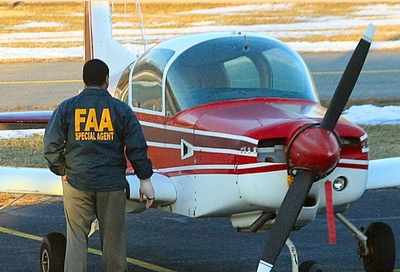Fri, Aug 21, 2015
For Recreational Flyers A Ramp Check Can Sound Scary, But If You Know The Rules It’s No Big Deal
Most Federal Aviation Regulations make sense because they are aimed at aviation safety, and while some of the safety related rules may seem arbitrary, it could be said they are well intended. Other rules may not be safety related, and they are usually rules that require pilots to show compliance with the regulations. This is what a ramp check is all about

When we use the term ramp check, we are not talking about the unfortunate cases of pilots being approached and questioned by military uniformed personnel from various government agencies. What we are reviewing is the simple case of an FAA operations inspector walking up in civilian clothes, shaking your hand, and announcing that you’re about to receive a ramp check.
The purpose of the ramp check is to verify that the pilot and aircraft are in compliance with the certification regulations. In other words, your paperwork had better be in order. Let’s review what must be with you when you act as a pilot-in-command (PIC).
The pilot must have the following items in his or her possession and must present them upon request by an FAA or law enforcement official:
- FAA pilot certificate.
- Government issued photo identification. This is commonly a state driver’s license, but other government issued photo identification is acceptable.
- Proof of appropriate medical certification. For a sport pilot or sport pilot student, this could be an FAA medical certificate or a valid state driver’s license.
- A student pilot must have his or her logbook on cross country flights, and a sport pilot must have either his or her logbook with the appropriate sport pilot endorsements or a record of the endorsements. Recreational pilots must also have proof of endorsement for extended cross-country flying and tower controlled airspace training if they had received those endorsements.
- Private and higher-rated pilots are not required to carry logbooks with them, and that’s probably a pretty good idea. However the FAA inspector may ask you to present some sort of proof of appropriate endorsements, such as a flight review, within a reasonable period of time.
The aircraft must also have certain papers to be legal to operate. They are:
- The airworthiness certificate must be onboard and must be displayed so that it is visible in the cockpit.
- The registration certificate has be onboard the aircraft and the address and ownership information on record with the FAA must be accurate and up-to-date. Remember, the registration certificate must be renewed every 3 years.
- The operating limitations must be onboard the aircraft. This could be part of the aircraft operating handbook or it could be a separate document, such as with experimental aircraft, and it may also certain include placards.
If you want the actual details of what the FAA inspector is authorized to do on a ramp check, it’s found in FAA Order 8900.1, Chapter 1, Section 4, and Titled: Conduct a FAR Part 91 Ramp Inspection.
With a little preparation and a calm demeanor, receiving a ramp check is not that big of a deal.
(Image from file)
More News
The Industry Continues to be Rocked By Some Questionable Operations Recent investigations and a great deal of data has resulted in ANN’s SportPlane Resource Guide’s rep>[...]
Make Sure You NEVER Miss A New Story From Aero-News Network Do you ever feel like you never see posts from a certain person or page on Facebook or Instagram? Here’s how you c>[...]
Visual Approach Slope Indicator (VASI) An airport lighting facility providing vertical visual approach slope guidance to aircraft during approach to landing by radiating a directio>[...]
Airport Marking Aids Markings used on runway and taxiway surfaces to identify a specific runway, a runway threshold, a centerline, a hold line, etc. A runway should be marked in ac>[...]
Aero Linx: The Skyhawk Association The Skyhawk Association is a non-profit organization founded by former Skyhawk Pilots which is open to anyone with an affinity for the A-4 Skyhaw>[...]
 Unfortunate... ANN/SportPlane Resource Guide Adds To Cautionary Advisories
Unfortunate... ANN/SportPlane Resource Guide Adds To Cautionary Advisories ANN FAQ: Turn On Post Notifications
ANN FAQ: Turn On Post Notifications ANN's Daily Aero-Term (04.29.24): Visual Approach Slope Indicator (VASI)
ANN's Daily Aero-Term (04.29.24): Visual Approach Slope Indicator (VASI) ANN's Daily Aero-Term (04.28.24): Airport Marking Aids
ANN's Daily Aero-Term (04.28.24): Airport Marking Aids ANN's Daily Aero-Linx (04.28.24)
ANN's Daily Aero-Linx (04.28.24)



